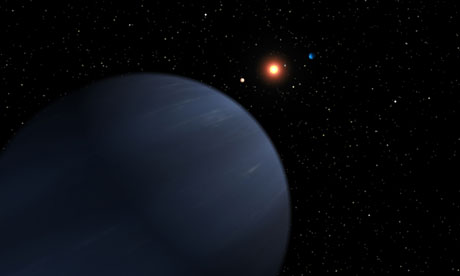There may be an Earth-like planet circling one in every four stars in the night sky, according to the first census of alien worlds in our celestial neighbourhood.
The survey is a yardstick for scientists searching for life elsewhere and suggests there could be 50bn planets with a similar mass to Earth in our own galaxy, the Milky Way.
Around a fifth of these distant Earths are expected to lie within their solar system's habitable or "Goldilocks zone", where the distance from the parent star keeps the planet's surface at just the right temperature for liquid water to form.
The presence of running water on a planet is widely regarded as a prerequisite for the emergence of life and underpins searches for extraterrestrials by Nasa and other space agencies.
Astronomers used the powerful Keck telescope on the Hawaiian island of Mauna Kea to count planets as they swung around 166 of our closest sun-like stars. The planets were too distant to see directly, but their stars were observed to wobble very slightly as they passed by.
The technique can only spot planets that orbit close to their stars and are substantially more massive than Earth.
In total, the astronomers detected 33 planets orbiting 22 stars, and the distribution of the planets showed they became more plentiful the lower their mass. By extrapolating from the census findings, the team worked out the odds of a star being orbited by smaller planets than those they could detect.
They estimate that 23% of sun-like stars are circled by an Earth-like planet, 12% are orbited by more massive "super-Earths" and around 1.6% are circled by planets similar to the gas giant, Jupiter.
"For the first time we have carried out a planet census among the sun-like stars in our neighbourhood of the galaxy. And now we know ... what fraction of the sun-like stars harbour planets of different sizes," saidGeoffrey Marcy, an astronomer at the University of California, Berkeley.
"It means we can look up at the stars at night and know that something like a quarter harbour a planet of nearly Earth's size," he added. The findings are reported in the journal, Science.
The results conflict with researchers' models of how planets fall into orbit around their stars. It had been thought that after planets were born from cosmic dust and detritus, they spiralled in towards their parent star but left swathes of empty space close in, said Andrew Howard, who led the study. "We found lots of small planets very close to their stars, where the models say there should be nothing," he said. "It means that our popular model of planet formation has problems."
It will be some time before scientists can be sure there are truly Earth-like planets in our cosmic backyard. The Berkeley team detected planets by their mass alone, but know nothing about their sizes. This makes it impossible to answer crucial questions such as whether the planets are wet and rocky like Earth, or are inhospitable gas balls or giant water worlds.
Clarification is expected to come from Nasa's Kepler space telescope, which is searching for Earth-sized planets around more than 156,000 stars. In June, Kepler scientists reported that they had spotted 706 possible alien worlds as they passed across the face of their parent stars. Based on their census, Howard and Marcy believe Kepler will find between 120 and 260 "plausibly terrestrial worlds".





